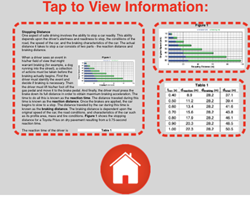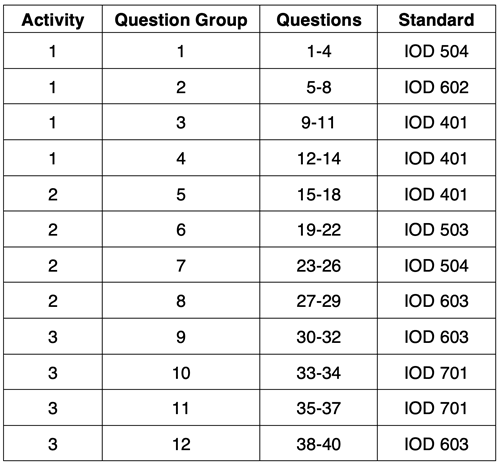About the Science Reasoning Center
 Highly Recommended
Highly RecommendedLike all our Science Reasoning Center activities, the completion of the Stopping Distance activity requires that a student use provided information about a phenomenon, experiment, or data presentation to answer questions. This information is accessible by tapping on the small thumbnails found on the bottom right of every question screen. However, it may be considerably easier to have a printed copy of this information or to display the information in a separate browser window. You can access this information from this page.
The Standards
The Stopping Distance activity presents data regarding the relationship between reaction time, car speed, reaction distance, braking distance, and total stopping distance. The data is presented in the form of a bar chart and a data table. Students must recognize and use numerical patterns, select relevant data from a graph or table, combine information from two or more data presentations to answer questions, and interpolate and extrapolate using the provided data. Success with the activity requires some degree of proficiency with respect to ...
- Analyzing and Interpreting Data (Science and Engineering Practice 4.1)
Analyze data using tools, technologies, and/or models (e.g., computational, mathematical) in order to make valid and reliable scientific claims. - Using Mathematics and Computational Thinking (Science and Engineering Practice 5.3)
Use mathematical, computational, and/or algorithmic representations of phenomena to describe and/or support claims and/or explanations.
While the Stopping Distance activity addresses the two NextGen Science and Engineering Practices above, the activity drew its greatest inspiration from ACT's College Readiness Standards for Science Reasoning. The activity consists of 40 questions organized into 12 Question Groups that are spread across the three activities. The relationship between the questions and the standards is shown in the table below. Each question falls within the Interpretation of Data strand of the science reasoning standards. Higher numbers correlate to more complex skills. ACT's Table of Science Reasoning Standards can be consulted specifics about each of the listed standards. The relationship between the questions and the standards is as follows:

Complementary and Similar Resources
The following resources at The Physics Classroom website complement the Stopping Distance Science Reasoning Activity. Teachers may find them useful for supporting students and for crafting lesson plans and unit plans.
The Physics Classroom Tutorial: Kinematics Chapter
Physics Interactives: Stopping Distance
Recommended: Print Passage, Tables, and Graphs
Also see: